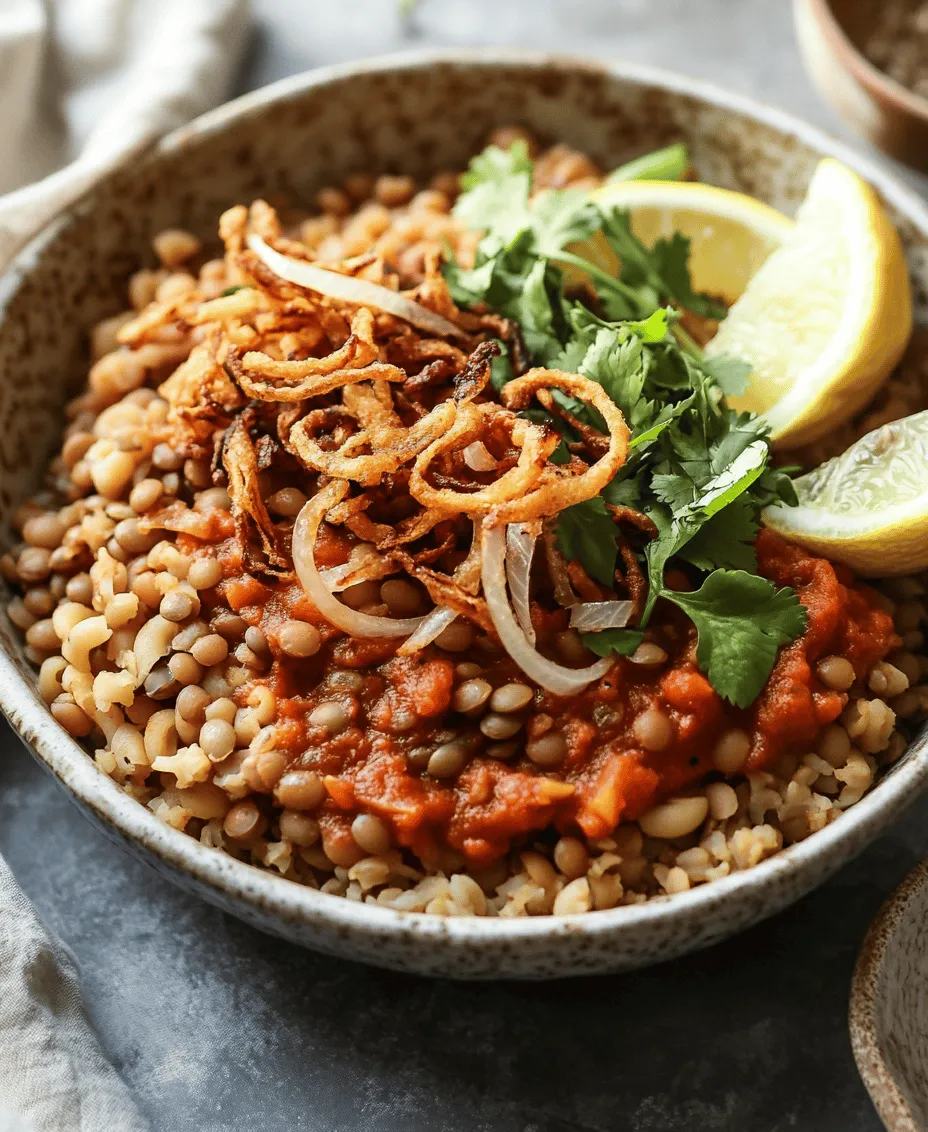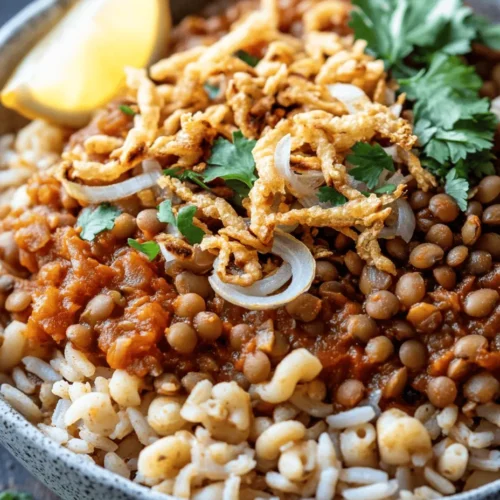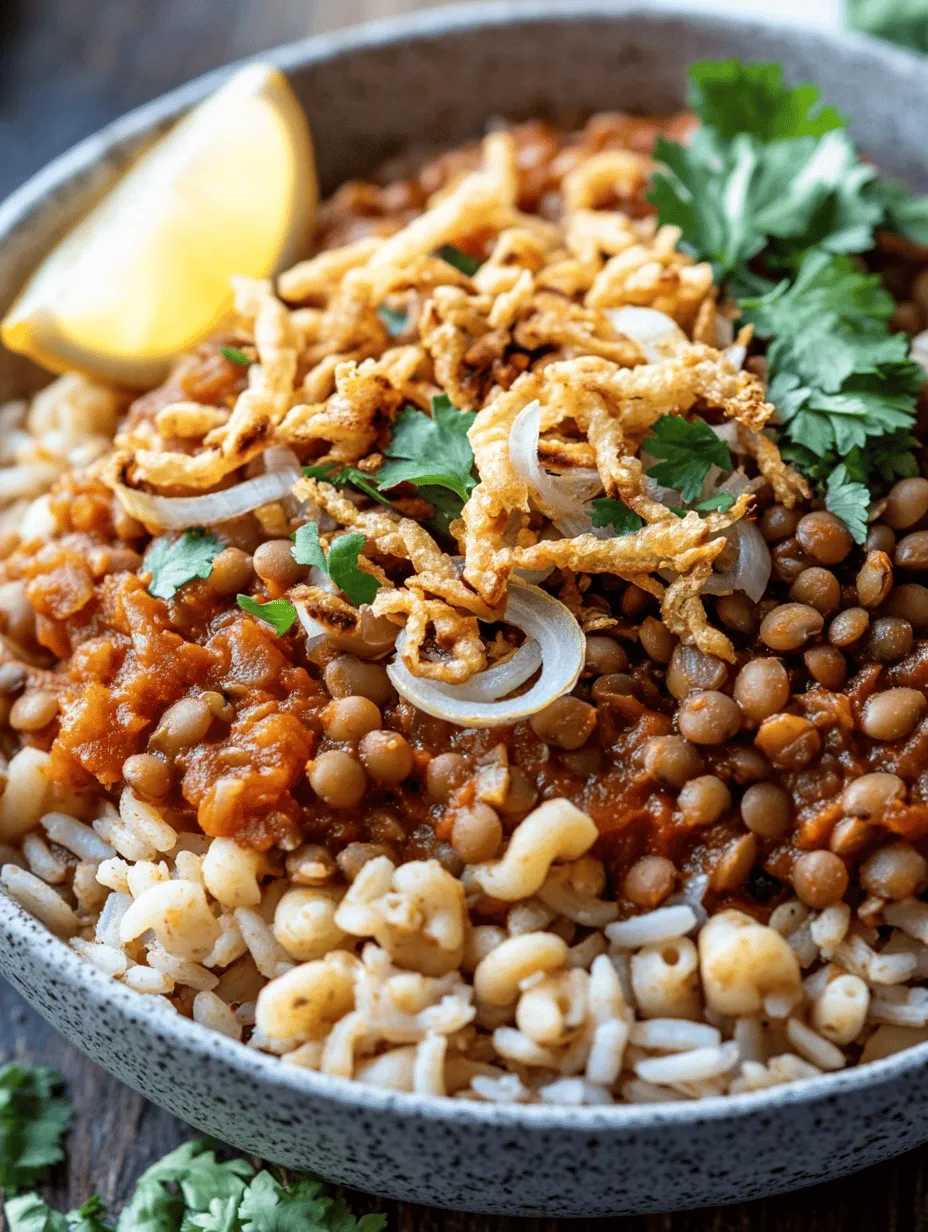Koshari, often hailed as Egypt’s national dish, is a quintessential representation of the country’s rich culinary heritage. This beloved comfort food, a hearty mix of lentils, rice, macaroni, chickpeas, and a zesty tomato sauce, is a staple in Egyptian households and street stalls alike. With its humble ingredients and robust flavors, Koshari embodies the essence of Egyptian cuisine—simple yet satisfying, nutritious yet indulgent.
Understanding Koshari: A Brief History and Cultural Significance
The origins of Koshari can be traced back to the early 19th century, where it emerged as a dish of necessity, combining various leftover staples to create a filling meal. It is believed to have been influenced by Italian, Indian, and Arab cuisines, reflecting Egypt’s historical trade connections and multicultural influences. Koshari was initially served in the homes of the working class, providing an affordable and hearty meal. Over time, it gained popularity among all social classes and evolved into a beloved street food, often sold from bustling stalls or small eateries.
This dish not only represents a culinary delight but also showcases the diversity and creativity of Egyptian cooking. It is a dish that brings people together; families gather around a plate of Koshari, sharing stories and laughter, making it a true comfort food. The combination of flavors and textures, along with its nutritional value, has solidified Koshari’s status as a beloved dish, making it a must-try for anyone looking to explore authentic Egyptian cuisine.
Ingredient Breakdown: Key Components of Koshari
To create the perfect bowl of Koshari, it is essential to understand the role each ingredient plays in this flavorful medley.
Lentils
Lentils are the backbone of Koshari, contributing both protein and fiber to the dish. They come in various types, including brown, green, and black lentils, each offering a different texture and flavor profile. For Koshari, brown lentils are commonly used due to their ability to hold their shape during cooking, providing a hearty and earthy base to the dish. Nutritionally, lentils are packed with essential vitamins and minerals, making them a healthy addition to this comfort meal.
Rice
The type of rice used in Koshari is crucial; long-grain rice is preferred for its fluffy texture and ability to separate easily during cooking. Jasmine or basmati rice is ideal, as they add a subtle fragrance to the dish. When cooked properly, the rice acts as a perfect canvas, absorbing the flavors of the lentils and the accompanying tomato sauce, enhancing the overall taste experience.
Macaroni
Pasta adds an interesting texture to Koshari, creating a contrast with the rice and lentils. Typically, small elbow macaroni is used, which can easily mix with the other ingredients. The addition of pasta not only makes the dish more filling but also provides a delightful chewiness that complements the softer elements.
Chickpeas
Chickpeas are another vital component, offering a creamy texture and nutty flavor that enhances the dish’s overall taste. They are an excellent source of protein, making Koshari a balanced meal. When cooked, the chickpeas add a slight crunch, elevating the texture and making each bite satisfying.
Tomato Sauce
The tomato sauce is the heart of Koshari, infusing the dish with vibrant flavors. Typically, it is made with fresh tomatoes, garlic, and spices, simmered to create a rich and tangy sauce that ties all the ingredients together. A well-prepared sauce is crucial for achieving the signature taste of Koshari, so using high-quality tomatoes and balancing the seasonings is essential.
Spices
Koshari is known for its aromatic spices, with cumin and paprika being the stars of the dish. Cumin, with its warm and earthy flavor, adds depth, while paprika brings a subtle sweetness and color. These spices not only contribute to the dish’s complexity but also enhance the overall flavor profile, making it irresistible.
Optional Ingredients
When it comes to garnishing Koshari, fresh cilantro and lemon wedges are popular choices. Cilantro adds a burst of freshness that brightens the dish, while a squeeze of lemon enhances the flavors, balancing the richness of the lentils and sauce. Though optional, these ingredients elevate the dish, providing an extra layer of flavor that many enjoy.
Step-by-Step Cooking Instructions for Koshari Delight
Creating Koshari is a straightforward process, but attention to detail is key for achieving the perfect texture and flavor. Below are the initial steps to prepare this delightful dish, starting with cooking the lentils.
Cooking the Lentils
1. Rinse and Soak: Begin by rinsing 1 cup of brown lentils under cold water to remove any impurities. Soaking the lentils for about 30 minutes can help to soften them, although this step is optional.
2. Boil the Lentils: In a medium pot, add the soaked lentils and cover them with water. Bring to a boil over medium heat, then reduce to a simmer. Cook for about 15-20 minutes or until the lentils are tender but not mushy. Keep an eye on them, as overcooking can lead to a mushy texture that won’t hold up in the final dish.
3. Drain and Set Aside: Once cooked, drain the lentils in a colander and place them aside to cool. This will help them maintain their shape when mixed with the other ingredients.
Preparing the Rice
1. Rinse the Rice: While the lentils are cooking, rinse 1 cup of long-grain rice under cold water until the water runs clear. This step removes excess starch and helps prevent the rice from becoming sticky.
2. Cook the Rice: In a separate pot, bring 2 cups of water to a boil. Add the rinsed rice along with a pinch of salt. Stir once, then cover the pot and reduce the heat to low. Allow the rice to simmer for about 15-20 minutes, or until all the water has been absorbed and the rice is fluffy.
3. Fluff the Rice: Once the rice is done cooking, remove it from heat and let it sit covered for an additional 5 minutes. Fluff it gently with a fork before serving to ensure it remains light and airy.
By mastering these initial steps, you set a solid foundation for creating Koshari Delight. The combination of perfectly cooked lentils and rice will ensure that your dish has the right texture and flavor, making for a truly comforting meal. As you continue through the recipe, the next steps will involve preparing the macaroni, chickpeas, and the flavorful tomato sauce, leading you closer to serving this iconic Egyptian dish.

Cooking the Macaroni
To achieve the perfect Koshari, the macaroni is a crucial component that adds texture and heartiness to the dish. Begin by bringing a large pot of salted water to a rolling boil. Once boiling, add the macaroni (about 1 cup), stirring occasionally to prevent sticking.
Ensuring Pasta is Perfectly Al Dente
The key to great macaroni in Koshari is cooking it al dente, which means it should be tender but still firm when bitten. Check the pasta package for cooking times, usually around 7-9 minutes. To ensure you don’t overcook, start tasting a minute or two before the minimum time indicated. Once done, drain the pasta in a colander and rinse under cold water to stop the cooking process. Toss it lightly with a drizzle of olive oil to prevent sticking and set it aside for assembly.
Frying the Onions
Crispy fried onions are an iconic topping for Koshari, adding a delightful crunch and rich flavor. To prepare them, slice 2 medium onions thinly. Heat a generous amount of vegetable oil in a deep skillet or frying pan over medium heat.
Techniques for Crispy and Flavorful Onions
To achieve the perfect crispy onion, ensure the oil is hot enough before adding the sliced onions; test by dropping in a small piece—if it sizzles, you’re ready. Fry the onions in batches to prevent overcrowding, which can lead to steaming rather than frying. Stir occasionally until they turn golden brown and crispy, about 8-10 minutes. Once they’re done, use a slotted spoon to transfer them to a paper towel-lined plate to drain excess oil. Season them lightly with salt while they are still hot for added flavor.
Preparing the Tomato Sauce
The tomato sauce is where Koshari truly shines, bringing a punch of flavor that ties all the ingredients together. Start by heating 2 tablespoons of vegetable oil in a saucepan over medium heat. Add 4 cloves of minced garlic and sauté until fragrant, about 1 minute.
Balancing Flavors with Vinegar and Spices
Next, add 1 can (15 ounces) of crushed tomatoes, 1 teaspoon of ground cumin, 1 teaspoon of coriander, and a pinch of red pepper flakes for heat. Simmer the mixture for 10-15 minutes, allowing it to thicken and the flavors to meld. To finish, stir in 2 tablespoons of white vinegar and season with salt and pepper to taste. The vinegar adds a tangy brightness that balances the richness of the dish.
Assembling the Koshari
Now that all components are ready, it’s time to assemble the Koshari. Begin with a layer of the cooked rice at the bottom of a serving bowl. Follow this with a generous scoop of the macaroni, then layer on the lentils.
Layering the Ingredients for Visual Appeal and Taste
Spoon the tomato sauce over the layered ingredients, allowing it to soak into the rice and pasta. Finally, top it all with the crispy fried onions. For added appeal, finish with a sprinkle of fresh parsley or cilantro for a pop of color. This layered presentation not only looks stunning but also ensures every bite is a delightful mix of flavors and textures.
Serving Suggestions
Koshari is best served hot and can be accompanied by various sides for a complete meal. Consider offering a small bowl of extra tomato sauce on the side for those who enjoy a bit more sauciness.
Presentation Tips and Serving Styles
For an authentic experience, serve Koshari in individual bowls or on a large communal platter, making it a perfect dish for sharing with family and friends. Pair it with a side of Egyptian bread for a traditional touch. You might also consider adding a simple cucumber and tomato salad dressed with olive oil and lemon juice for a refreshing contrast to the hearty Koshari.
Nutritional Analysis of Koshari Delight
Koshari is not only delicious but also offers several health benefits, making it a well-rounded meal option. It is primarily composed of carbohydrates from rice, pasta, and lentils, which provide a steady release of energy.
Overview of the Health Benefits of Koshari
The lentils in Koshari are rich in protein and fiber, which can aid in digestion and promote satiety, making this dish a great choice for vegetarians and vegans alike. Additionally, the use of fresh ingredients and spices contributes to its nutritional value, providing vitamins and minerals.
Discussion on Vegetarian and Vegan Aspects
Koshari is inherently vegetarian and can easily be adapted for vegan diets. The absence of meat and dairy makes it a fantastic option for those looking to enjoy a hearty meal without animal products.
Caloric Breakdown per Serving
A standard serving of Koshari (approximately 1 cup) typically contains about 350-400 calories, depending on the specific ingredients and portions used. This caloric content provides a satisfying and wholesome meal without being overly indulgent.
Exploring Variations of Koshari
Koshari is a versatile dish with numerous regional variations within Egypt. In different cities, you may find local twists on the classic recipe, often incorporating unique spices or additional ingredients.
Regional Variations within Egypt
For instance, in Cairo, Koshari might be topped with chickpeas or served with a spicy garlic sauce, while in Alexandria, you may find it garnished with fried eggplant slices. Each region boasts its own adaptations, reflecting local tastes and preferences.
Creative Twists and Modern Adaptations of Koshari
In recent years, chefs have begun to experiment with Koshari by introducing creative twists, such as incorporating quinoa instead of rice for a gluten-free option, or adding roasted vegetables for extra flavor and nutrition. These modern adaptations cater to diverse dietary preferences while maintaining the essence of this beloved dish.
Options for Dietary Restrictions (Gluten-Free, etc.)
For those with gluten intolerance, consider using gluten-free pasta or substituting the macaroni with other grains like farro or millet. Such adaptations keep Koshari inclusive, allowing everyone to enjoy this Egyptian comfort food.
Pairing Koshari with Traditional Egyptian Beverages
To round out your Koshari experience, consider pairing it with traditional Egyptian beverages that complement the dish beautifully.
Popular Drinks that Complement Koshari
Hibiscus tea (Karkadeh) is a popular choice, known for its refreshing and slightly tart flavor, which balances the richness of Koshari. Tamarind juice is another excellent option, offering a sweet and tangy contrast that enhances the overall dining experience.
Overview of Egyptian Drinks like Hibiscus Tea and Tamarind Juice
Hibiscus tea is not only refreshing but also packed with antioxidants, while tamarind juice provides a unique flavor profile that enhances the enjoyment of Koshari. Both drinks can be served chilled, making them perfect for warm days or festive gatherings.
Conclusion: The Comfort and Community of Koshari
Koshari is more than just a meal; it’s a symbol of comfort and community in Egyptian culture. This dish is often enjoyed during family gatherings, celebrations, or as a beloved street food. Its layers of flavors and textures mirror the richness of Egyptian heritage, making it a dish that unites people around the dining table.
Encouraging others to explore and create Koshari at home allows them to experience a taste of Egypt, fostering a deeper appreciation for this traditional cuisine. Whether enjoyed as a comforting weeknight dinner or a festive gathering centerpiece, Koshari delights the palate and warms the heart, making it a cherished dish for generations to come.



